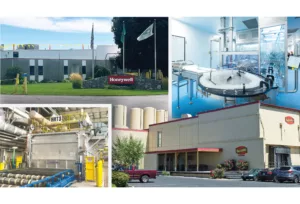
Home » Wet-lab space for young companies said lacking
Wet-lab space for young companies said lacking
SIRTI hopes to add labs; UI Research Park brings space for biotechs on line
February 26, 1997
A new building in the University of Idaho Research Park in Post Falls isnt even done yet, but nearly all of the laboratory space that will be in it is spoken for already.
Also, all of the wet-lab space at the Spokane Intercollegiate Research and Technology Institute is in use, and SIRTI now is scrambling to add more.
Meanwhile, the recently constructed Health Sciences Building at the Riverpoint Higher Education Park has a lot of wet-lab space, but all of it will be used for academic pursuits, rather than private enterprises.
Wet-lab space for emerging companies is very scarce, says Dr. C. Harold Mielke, director of Washington State University at Spokanes Health Research and Education Center.
Biotech observers here discuss the issue with a mix of concern and enthusiasm.
Its a good problem to have, because it shows demand, says Hank Artis, incubator and business services manager at SIRTI. Its a good problem to have, and weve got it.
Walter Plosila, a Cleveland-based vice president of public technology management for Battelle Memorial Institute, concurs.
Having a shortage of wet-lab space is a sign that your cluster is going, he told a biotech forum audience here earlier this month.
The amount of wet-lab space, usually defined as having sinks, a deionized water supply, ventilation hoods, and other specialized components, is increasing here.
The new facility at UIs park in Post Falls will have about 5,000 square feet of wet-lab space, which is about a sixth of the buildings total space, says Doug McQueen, the parks director. Construction of that building is wrapping up, and the first tenants are scheduled to move in next week.
McQueen says all but about 1,000 square feet of the lab space there is spoken for already, and he currently is marketing the remaining two lab spaces to private companies. Whether that space is taken quickly should be a good gauge of demand.
Itll probably go pretty fast, he says.
The new structure is the first developed by the UI at the research park. The university has proposed developing a second structure at the park that would include 40,000 square feet of floor space, a significant portion of which would be wet-lab space, McQueen says. Plans for that building currently are on hold, however, due to the state of Idahos budgetary constraints.
In Spokane, SIRTI hopes to double, to 4,000 square feet, the amount of wet-lab space in the basement of its building, which is located in the Riverpoint Higher Education Park east of downtown. To accomplish that, the institute would like to convert 2,000 square feet of storage space into wet-lab space. One of the wet labs would be a clean room with an advanced air-filtration system.
Artis says SIRTI is working with the Spokane Area Economic Development Council to obtain U.S. Economic Development Administration grant funds to pay for the conversion. He says that if the institute secures such a grant, as well as matching funds, it will be able to add the additional lab space within two years.
A few companies share the current wet-lab space at SIRTI, but it mostly is used by Biomedex Inc., a Spokane contract manufacturing and consulting company that primarily serves the bio-pharmaceutical industry.
WSU-Spokanes recently completed Health Sciences Building, which also is located on the Riverpoint campus, includes about 11,000 square feet of wet-lab space, all of which will be in use by the end of the year, Mielke says. That space, however, will be used exclusively for university staff research, rather than by private companies, he says.
Some established biotech companies here also have wet-lab space for their own proprietary ventures, but developing such labs is expensiveusually prohibitively expensivefor young companies that are just starting up.
Bruce Thompson, an architect and WSU-Spokanes assistant director of facilities development, says construction costs for wet-lab space range from $200 to $300 per square foot of floor space, not counting the expensive and highly specialized equipment that typically goes into such labs.
Thats usually the most expensive part of any facility that we build, he says.
In addition to sinks, deionized water supplies, special ventilation hoods, and gas outlets, such labs usually include upgraded electricity distribution systems. They also must have multiple exits and safety equipment, such as decontamination showers for workers. Special lab equipment ranges from incubators to ultra-cold refrigerators.
The term dry lab is more nebulous. For instance, it could be a computer room at which a researcher interprets data for a project.
McQueen says that while many biotech businesses need wet labs, much of the research that had been conducted in labs previously now is being done with computers.
A lot of people that needed wet-lab space 10 years ago dont need it today, he says. As virtual reality increases, the need for physical experimentation will lessen.
Mielke says, however, that many areas of research still center around work in wet labs, and the need for such labs likely will increase in coming years here, especially if an endeavor that the medical-research community is working on takes flight.
In that endeavor, Mielke says he and other biomedical proponents here are looking to form a medical research institute through which Spokane-area hospitals and universities could share resources for studies on topics including heart disease, diabetes, and neurological disorders.
Researchers in the San Francisco Bay area formed a similar institute many years ago, and many prominent biotech companies have spun out of that effort, says Mielke, who was involved in medical research there at the time.
Such an institute likely would be affiliated with the Health Research and Education Center that Mielke oversees. If federal funds are secured, an institute could be operational in three to five years, Mielke says.
If this MRI (medical research institute) concept gets funded, there will have to be a rapid expansion of space, he says. Five years from now, it could be a different ball game.
Latest News
Related Articles



_web.webp?t=1764835652)
